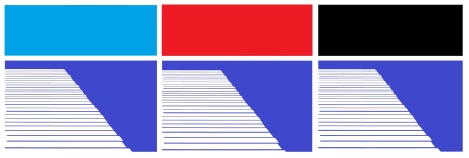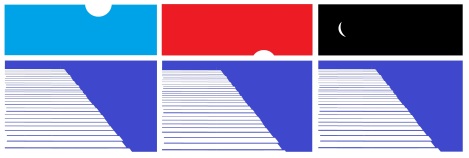I’m going to say no. Though why, I’m less sure. The image does include three panels, and if you read then sequentially, then that’s a comic. It’s even a kind of narrative: a short page’s descent into black. The three panels of color might even take on metaphorical meaning.
The problem is whether that descent from light blue to red to black really is sequential, or if you read the three blocks of color simultaneously, like a flag:

The French flag is not a comic strip. It’s also not a narrative. Though I’m not sure whether narrative is a requirement for a comic. Comics can be abstract, but can an abstract image still have a narrative? Does narrative require representational imagery in order to divide the page into a sequence? Can a purely abstract image even have sequence? If I rearrange “a short page’s descent into black” into “a wide strip’s left-to-right progression into black,” is it more narrative-ish?
Not really. But if I add minimal representational elements, do the same three blocks of color become a narrative?
Each block has its own partial white circle, and those circles have iconic meaning. So instead of a progression into generic black, is it now a progression into Night? Is the blue also Day and the red Evening?
Read that way, the three panels are not only representational, they now represent the same space. Though your eye moves left to right to read them, your brain understands that within the world of the image your eye is stationary as you blink through three snapshots, each divided by a time span of something like six hours. The bottom edge of the frames also becomes a repeated horizon line.
Which is a lot of information for just three partial circles to convey. So what if I include only one of the circles? What exactly is the minimal requirement for an image to be representational?
Of course now that you “know” the middle circle is the sun, it’s probably impossible not to read the image representationally, and therefore narratively. I could instead leave out all of the partial circles and include some other detail to establish a representational setting.
Now we’re looking at the changing sky beyond a seaside dock. The noon sun is “above” the top frame of the first panel; the newly set sun is “beneath” the horizon line of the middle panel, and the sun is even further “beneath” the same internal line in the last panel. Compared to the water and the blocks of sky, the boards of the dock are teeming with detail. But if that’s still too abstract, drop the partial circles back in.
I could call the three-panel strip “Dock Sunset.”
More weirdly, I could call the first flag-like sequence the same thing. The three formerly abstract rectangles of color are now both representational and fully narrative.






That’s funny – I once did a strip with the danish flag as its frames:
http://tegnebordet.dk/tegninger/5128/1191952075.png
Kasper, that’s a great combination of a flag (a single image) and comics (sequential images). Your brain has to understand the page both ways for it to make sense.
I find it interesting when flags or political symbols are used in editorial strips as a form of symbolism. Just think how a few innocuous shapes can form something with as much horrible history as the Nazi Swastika, or by putting a dove somewhere you can show peace.